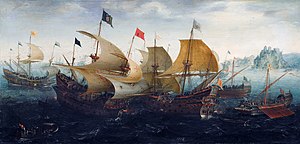Kindred Wars
This article is a work-in-progress because it is incomplete and pending further input from an author. Note: The contents of this article are not considered canonical and may be inaccurate. Please comment on this article's talk page to share your input, comments and questions. |
| Kindred Wars | ||||||||
|---|---|---|---|---|---|---|---|---|
 Pelaxian galleon fighting Kiravian and Caphirian warships | ||||||||
| ||||||||
| Belligerents | ||||||||
|
|
|
| ||||||
| Commanders and leaders | ||||||||
|
|
|
| ||||||
Script error: The module returned a nil value. It is supposed to return an export table.Template:Campaignbox Kindred War
The Kindred Wars were a series of armed conflict involving Kiravian forces, in the form of the Bay Trading Company and Kerēgulan Merchants of the Tropics joint-stock companies, and Caphiria, against the Pelaxian Empire. Beginning in 1702, the conflict primarily involved the Kiravian companies invading Pelaxian colonies in the Kindred Islands known as “Las Jusonias”, Loa Republic, and the Pelaxian mainland. The war can be thought of as an extension of the Pelaxian expansion over the Loa archipelago at the time. However, the conflict had little to do with the war in Loa and served mainly as a way for Kiravia to gain an overseas empire and control trade at the cost of the Pelaxians. Caphirian forces also assisted the Kiravian at certain points in the war (though in later decades, Kiravian and Caphirian would become fierce rivals). Because of the commodity at the center of the conflict, this war would be nicknamed the Spice War.
The outcome was that Pelaxia successfully repelled Kiravian attempts to secure the small Pelaxian Jusonias while the Kiravians were the victors in the Krasoa Islands. Caphirian ambitions also greatly benefited from the long-standing war between their two main rivals in West Sarpedon.
Pelaxian resentment at Caphiria, which was perceived as having prioritized its own colonies and neglected to form a Pan-Sarpedonian alliance against Kiravian assertion, was a major contributing factor to the Pelaxian civil war and the future of Pelaxian foreign policy.
Introduction
Between the 13th and 16th centuries, naval traffic between the Tainean and Kindred seas greatly increased. Technological advances in energy generation, transportation, communication, and navigation enabled new maritime routes, allowing sailors to more effectively navigate trade winds and tropical storms around the equator. This facilitated longer times at sea, coupled with new geolocation techniques for open ocean navigation.
The unification of strong central feudal governments in the valleys of Pelaxia and Cartadania — under vassalage to Caphiria — enabled local kingdoms and duchies to accumulate large treasuries, which they used to sponsor and fund fledgling commercial fleets around the Catenias, even leading to the exploration of a direct trade route to Audonia, specifically to Daxia.
From Levantia, Burgundian expeditions increased the exploration of islands around the Tainean Sea, creating vast enclaves, often close to access points to the Kindred Sea. The most daring of these explorations outside of Sarpedon were those by Coscivian explorers, who reached the Krasoa Islands in the 14th century.
Sarpedon and Levantia soon found themselves in a period of economic transition, where large feudal sectors saw overseas trade as a new means of economic accumulation. This gave rise to an emerging mercantilism within governmental hierarchies and sparked open competition for securing strategic enclaves along the main trade routes to ensure the continuous flow of goods: fruits, spices, tea, copium, and even people. In other words, by the 16th century, the Kindred Sea was becoming the battleground for the emerging overseas commercial powers.